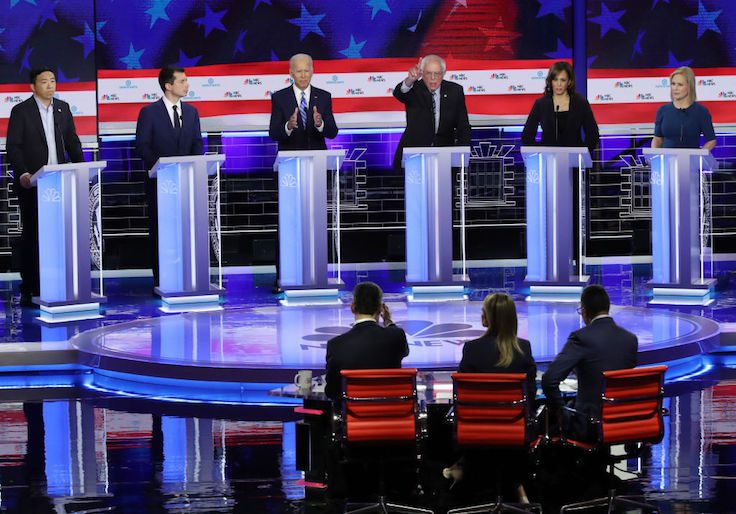Democratic candidates for the 2020 nomination have promised more than $210 trillion in new spending across the field, analysis by the Washington Free Beacon shows.
Of the 26 declared candidates—including Rep. Eric Swalwell (D., Calif.) who dropped out earlier this month—most have put enormous new government programs front and center in their campaigns. Totaling up these proposals gives taxpaying voters a sense of the budget priorities of the average Democratic candidate.
That overall figure is an undercount, as it is based only on proposals for which the Free Beacon could identify actual spending estimates. The true figure is much larger. For example, Sen. Bernie Sanders's (I., Vt.) Medicare for All proposal is included, while Sen. Kamala Harris's (D., Calif.) is not, because no cost assessment for the latter could be identified.
Candidates will continue to roll out proposals in the months ahead, although the field is likely to winnow in that time as well.
Of the $210 trillion, the plurality—$94 trillion—is the estimated cost of a Green New Deal, which a number of candidates have backed in some form or another. The remaining $116 trillion—roughly six times the United States's annual Gross Domestic Product—is spread across a variety of policy proposals, from Andrew Yang's Universal Basic Income to Marianne Williamson's call for $200 to $500 billion in reparations for slavery.
![]()
The Free Beacon largely employed the candidates' own cost estimates for their proposals. However, the analysis also cited a nonpartisan study showing Yang's proposed $12,000 income for all Americans would cost at least $30 trillion over the next decade; Yang claims it would cost $1.8 trillion a year.
Many of the proposals are spread out over 10 years, such as Joe Biden's $750 billion public option health care plan, Sen. Elizabeth Warren's (D., Mass.) $2 trillion investment in green research and manufacturing, and former HUD Secretary Julian Castro's $970 billion plan for affordable housing.
Although Yang's proposal is one of the larger ones offered, Sanders is the top prospective spender. His Medicare for All plan is expected to run around $32 trillion over the next 10 years—estimates vary—but on top of that, a Sanders administration would add trillions more in infrastructure spending, universal free college, and an ill-defined job guarantee.
![]()
More mainstream Democrats like Biden, former representative John Delaney (D., Md.), and Sen. Kirsten Gillibrand (D., N.Y.) are big spenders as well. All three make it to the top five because of their promises to spend enormous sums of money combatting climate change: $4 trillion, $5 trillion, and $10 trillion, respectively.
Billionaire Tom Steyer ($2.25 trillion) and Washington governor Jay Inslee ($9 trillion, $3 trillion in public spending) have also proposed 13-figure climate change proposals.
![]()
Overhauling education is another popular policy proposal, with candidates like Castro seeking to spend trillions of dollars on it. For some, like Warren and Miramar, Fla., mayor Wayne Messam, that includes voiding all student debt, even though some plans to do so would disproportionately benefit the well-off.
Click here for a link to the spreadsheet of the spending proposals.
